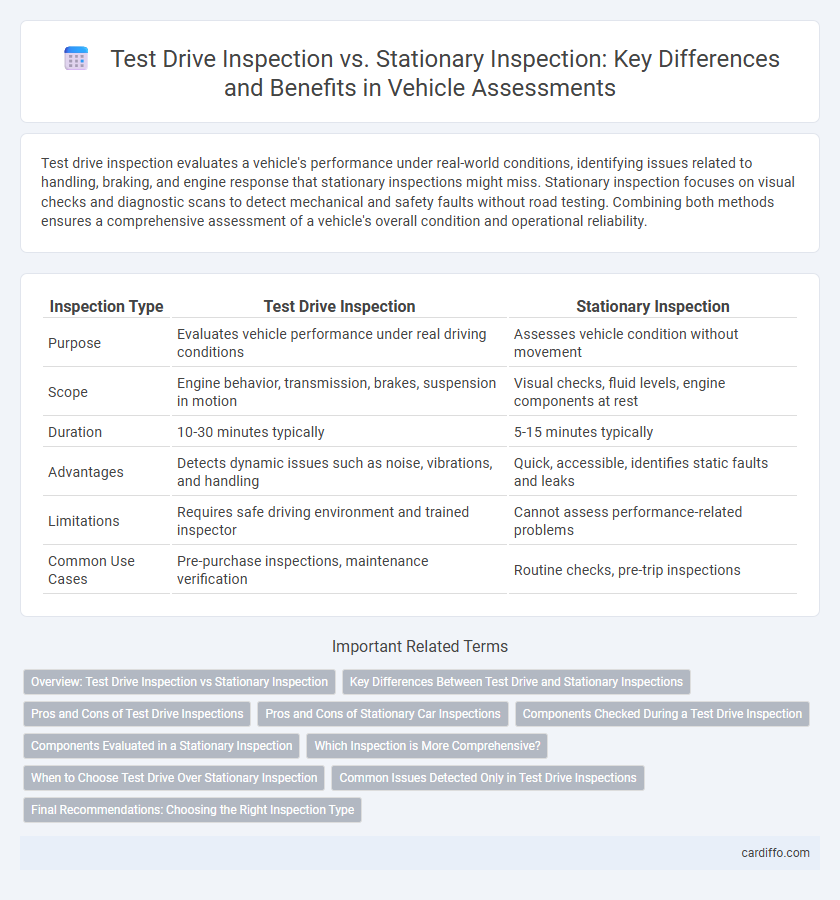Test drive inspection evaluates a vehicle's performance under real-world conditions, identifying issues related to handling, braking, and engine response that stationary inspections might miss. Stationary inspection focuses on visual checks and diagnostic scans to detect mechanical and safety faults without road testing. Combining both methods ensures a comprehensive assessment of a vehicle's overall condition and operational reliability.
Table of Comparison
| Inspection Type | Test Drive Inspection | Stationary Inspection |
|---|---|---|
| Purpose | Evaluates vehicle performance under real driving conditions | Assesses vehicle condition without movement |
| Scope | Engine behavior, transmission, brakes, suspension in motion | Visual checks, fluid levels, engine components at rest |
| Duration | 10-30 minutes typically | 5-15 minutes typically |
| Advantages | Detects dynamic issues such as noise, vibrations, and handling | Quick, accessible, identifies static faults and leaks |
| Limitations | Requires safe driving environment and trained inspector | Cannot assess performance-related problems |
| Common Use Cases | Pre-purchase inspections, maintenance verification | Routine checks, pre-trip inspections |
Overview: Test Drive Inspection vs Stationary Inspection
Test drive inspection involves evaluating a vehicle's performance under real driving conditions, assessing factors such as engine responsiveness, braking efficiency, and suspension stability. Stationary inspection focuses on examining the vehicle's components and systems without movement, including engine diagnostics, fluid levels, and brake functionality. Both methods provide critical insights, with test drive inspections revealing dynamic issues and stationary inspections identifying static faults.
Key Differences Between Test Drive and Stationary Inspections
Test drive inspections evaluate a vehicle's performance under real driving conditions, identifying issues related to engine response, transmission shifts, and suspension behavior that stationary inspections might miss. Stationary inspections concentrate on visual checks, fluid levels, and component conditions without operation stress, making them ideal for detecting leaks and wear. Both methods complement each other, with test drives revealing dynamic faults and stationary inspections ensuring mechanical components meet safety standards.
Pros and Cons of Test Drive Inspections
Test drive inspections provide real-time data on vehicle performance, revealing issues like engine misfires, transmission problems, and braking irregularities that stationary inspections may miss. However, they can be limited by weather conditions, driver skill variability, and the inability to thoroughly check under-the-hood components during motion. Despite these constraints, test drive inspections offer critical insights into dynamic vehicle behavior essential for comprehensive diagnostics.
Pros and Cons of Stationary Car Inspections
Stationary car inspections offer precise diagnostics of engine performance, emissions, and fluid levels without the variability introduced by driving conditions. These inspections allow for controlled environment testing, reducing external factors that might affect the accuracy of results but cannot fully assess dynamic issues like brake performance or suspension behavior under load. Limited by the absence of real-world driving scenarios, stationary inspections may miss problems detectable only during motion, necessitating complementary test drive evaluations for comprehensive vehicle assessment.
Components Checked During a Test Drive Inspection
A test drive inspection evaluates dynamic vehicle components such as the suspension, transmission, brakes, steering, and engine performance under real-world driving conditions. This process identifies issues like unusual noises, vibrations, brake responsiveness, and acceleration problems that stationary inspections may miss. Test drive inspections complement stationary checks by revealing functional defects impacting safety and drivability during operation.
Components Evaluated in a Stationary Inspection
Stationary inspections focus on evaluating key vehicle components such as brake systems, steering mechanisms, suspension parts, and exhaust emissions without requiring the vehicle to be driven. This type of inspection allows for detailed assessments of fluid levels, tire condition, lighting functionality, and undercarriage integrity. By assessing these critical components while the vehicle is at rest, inspectors can identify potential safety hazards and mechanical issues that might not be apparent during a test drive.
Which Inspection is More Comprehensive?
Test drive inspection offers a more comprehensive evaluation by assessing a vehicle's performance under real driving conditions, including engine response, braking efficiency, and suspension behavior. Stationary inspection, while effective for checking static components such as fluid levels, tire pressure, and visual damage, cannot detect issues arising from dynamic stresses. Overall, test drive inspections provide a deeper insight into operational reliability and potential safety concerns compared to stationary methods.
When to Choose Test Drive Over Stationary Inspection
Choose a test drive inspection over a stationary inspection when evaluating vehicle performance under real-world driving conditions, such as engine responsiveness, braking efficiency, and suspension behavior. Test drive inspections are essential for identifying dynamic issues like transmission shifts, steering alignment, and unusual noises that static inspections may overlook. Opt for test drive inspections during pre-purchase evaluations or after repairs to ensure the vehicle operates correctly in various driving scenarios.
Common Issues Detected Only in Test Drive Inspections
Test drive inspections reveal issues such as transmission slipping, engine misfires, and abnormal brake behavior that are often undetectable during stationary inspections due to the dynamic conditions involved. Problems like uneven acceleration, steering vibrations, and faulty suspension performance become evident only when the vehicle is in motion. These real-world driving factors make test drive inspections critical for comprehensive vehicle diagnostics.
Final Recommendations: Choosing the Right Inspection Type
Final recommendations for selecting the appropriate inspection type prioritize the inspection objective and vehicle condition. Test drive inspections provide dynamic performance insights, crucial for identifying issues related to handling, braking, and engine response. Stationary inspections excel in detailed component analysis and systems diagnostics, suitable for in-depth mechanical evaluation without road influence.
Test drive inspection vs stationary inspection Infographic

 cardiffo.com
cardiffo.com